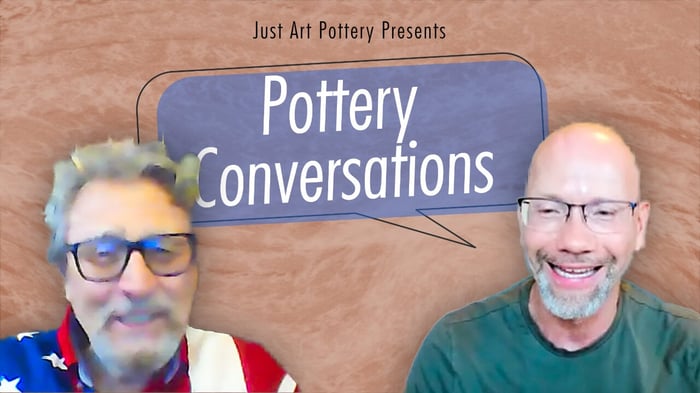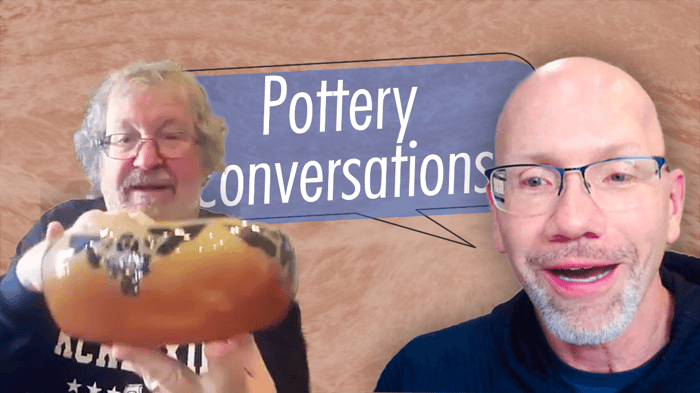Welcome to Pottery Conversations hosted by JustArtPottery.com Owner, Greg Myroth, where we delve into the world of vintage and collectible art pottery! From renowned experts and authors to passionate collectors and seasoned dealers, we'll bring you insightful conversations that celebrate the beauty and craftsmanship of American art pottery and European ceramics. Whether you're a seasoned collector or just beginning your journey into the world of art pottery, there's something for everyone on Pottery Conversations. Subscribe and stay tuned for uploads and highlights from each episode.
University of North Dakota (UND) Pottery - Pottery Conversations - Episode 3
In this episode of Pottery Conversations, we will wrap up our discussion with University of North Dakota (UND) Pottery expert, Tony Olsen, about key factors in determining value: rarity, desirability, condition, and quality/aesthetics and the challenges that come with valuing UND pottery due to the large volume of student-made pieces with varying quality levels. This is because even poor-quality UND pottery with the school's stamp can be priced exorbitantly, confusing collectors about fair market value.
Also discussed is authenticating and identifying hand-crafted vs mass-produced UND pottery, which is crucial for accurate valuation. It’s been challenging because auction houses have contributed to pricing confusion by mislabeling mass-produced pieces.
Finally, discussed are ways in which condition is important and how seeking transparency about any repairs/damage is needed when buying/selling. Tony talks about some of the challenges with online selling platforms and auctions, including inflated prices, misinformation, and bidding wars driving up costs. A tip from Tony is to remember that doing thorough research is vital to understand true market value rather than relying on asking prices and that rare, high-quality pieces by renowned artists/exceptional students are considered valuable investments despite pricing difficulties.
00:00 - Start
00:43 - Four Markers For Valuation
03:25 - Confusion For New Collectors
11:05 - Condition And Its Impact On Value
15:09 - Affect Of E-Commerce On Valuation
24:28 - Does The Artist Affect The Value?
30:00 - Molded vs. Thrown, And Its Impact On Value
34:14 - Advice For New UND Collectors
42:49 - End
SUBSCRIBE for more Pottery Conversations episodes and highlights: https://www.youtube.com/@justartpotte...
More Information and Links:
North Dakota School of Mines History, Marks, Artists
University of North Dakota UND Pottery Collection
Collector's Encyclopedia of the Dakota Potteries: Identification & Values
University of North Dakota Pottery: A History and Comparative Study
University of North Dakota Pottery Cable Year
Kovels' American Art Pottery: The Collector's Guide to Makers, Marks, and Factory Histories
Summary of Episode 3
Greg and Tony discuss the key factors they consider when determining the value of University of North Dakota (UND) School of Mines pottery. They highlight four main points: rarity, desirability, condition, and quality/aesthetics. Tony notes that UND pottery is particularly challenging to price accurately due to the large volume of pieces produced by students, with a wide range in quality.
He explains that even poor-quality pieces with the UND stamp can be priced exorbitantly, which can confuse new collectors and make it difficult to establish fair market value. Overall, Greg and Tony emphasize the complexities involved in properly valuing UND pottery given the variations in rarity, demand, and craftsmanship. The speakers discuss the challenges of authenticating and valuing different styles of University of North Dakota (UND) pottery. They explain that UND pottery is highly varied, making it difficult to find comparable examples to establish value. The auction houses have also contributed to the confusion by mislabeling mass-produced pieces as hand-carved. The speakers highlight the importance of being able to identify the telltale signs of hand-crafting, such as visible tool marks, to determine the true value of a piece.
Tony and Greg share an anecdote about a collector who had a substantial collection of UND production pottery that the speaker was able to purchase for around $20,000 about 15-20 years ago, demonstrating the historical significance and value of these pieces. The speakers discuss the value and uniqueness of pottery, particularly the work of two student potters, Irene Nelson and Rue Schnell. They highlight how some of the most valuable pots were one-of-a-kind, hand-crafted pieces, rather than mass-produced.
The conversation also touches on the importance of condition when buying and selling pottery, with the speakers emphasizing the need for transparency around any repairs or damage, even if it doesn't significantly impact the value. They share personal experiences of buying damaged pottery online and the challenges involved in getting refunds or returns. The discussion highlights the challenges faced by pottery collectors and enthusiasts when navigating the online selling platforms and auction houses.
The speakers emphasize the importance of understanding the true value and rarity of pottery pieces, as well as the impact of condition on pricing. They caution against the inflated prices and misinformation that can arise, leading to confusion and potential exploitation of collectors. The speakers advocate for transparency, education, and a fair approach when buying and selling pottery to ensure a healthy and sustainable collecting community.

The speakers discuss the challenges of pricing and selling antique and collectible items, particularly on platforms like eBay and Etsy. They emphasize the importance of doing thorough research to understand the true market value of items, rather than relying on sellers' asking prices or auction results, which can be misleading. The speakers share personal experiences of negotiating prices and encountering discrepancies between their offers and the final auction prices. They acknowledge the difficulty of accurately valuing unique or rare items, and the need to be cautious when interpreting pricing data from various sources.
The speakers discuss the challenges of bidding on auction sites, where they face competition from buyers with deeper pockets and high buyer's premiums that can drive up costs significantly. They note that the shipping costs can also be a major factor, sometimes making an item unaffordable. However, the speakers still enjoy collecting pottery, particularly pieces by renowned artists or exceptional student works, which they view as valuable investments.
They discuss how to assess the value of a rare and high-quality piece, considering factors like rarity, desirability, condition, and quality. The speakers discuss the value and quality of different types of pottery, from mass-produced molded pieces to hand-thrown and hand-decorated works. They note that the time period and the level of artistry involved are key factors in determining the quality and value of a piece.
Both Greg and Tony highlight exceptional examples they have seen, such as hand-carved Viking ships and unique vases depicting women in sports, which are rare and highly prized. They emphasize that while molded pieces can be of high quality, the most valuable and sought-after pottery is often hand-thrown and hand-decorated by skilled artists. The importance of research and due diligence is emphasized when purchasing UND pottery, as the quality and rarity can vary greatly.
They recommend consulting books and experts to better understand the market and make informed buying decisions. Ultimately, the speakers advise collectors to trust their own aesthetic judgment and not solely rely on the stamp or reputation of a piece, as UND's output encompasses a wide range of styles and craftsmanship.
In this podcast dialogue, the speakers discuss the importance of being open-minded and seeking multiple perspectives when it comes to authenticating and understanding pottery. A story is shared about a piece of Natzler pottery sold, where the buyer later questioned its authenticity. Rather than argue, the speaker chose to refund the buyer's money, recognizing that there can be differing opinions on such matters. Both speakers emphasize the value of learning from experienced mentors and being willing to update one's knowledge as new information emerges. They also discuss the challenges of engaging younger generations in the pottery collecting community and the importance of creating educational content to preserve and share this knowledge.

The speakers discuss their shared passion for other American studio pottery, particularly the work of renowned potteries like Rookwood, Grueby, and Teco. Tony, who is based in North Dakota, notes that it can be challenging to find such pieces in his local area, but has had more success finding collections in Colorado and Utah as he has expanded his search.
Please listen for this and more!








